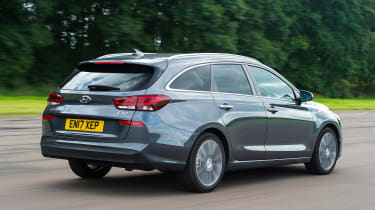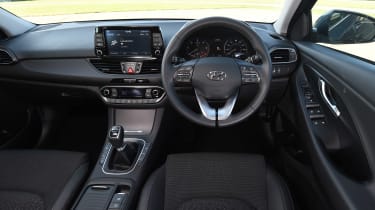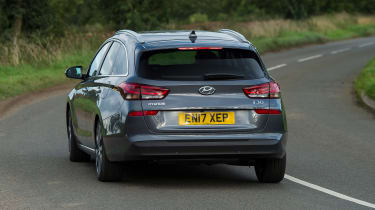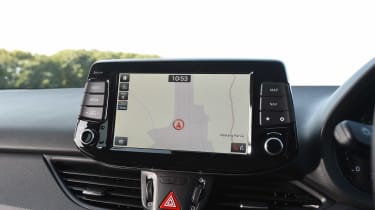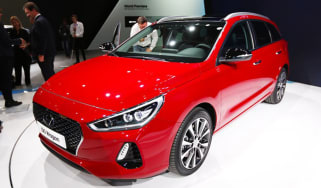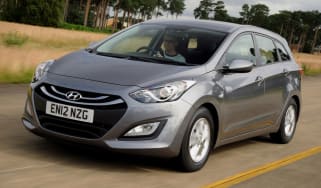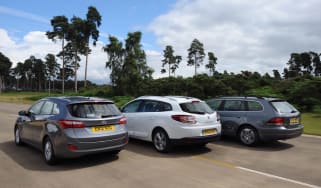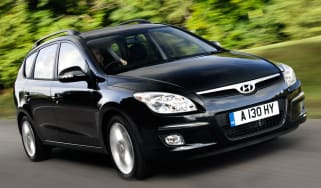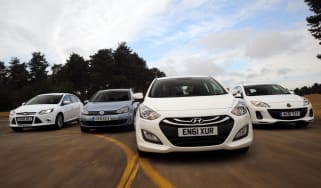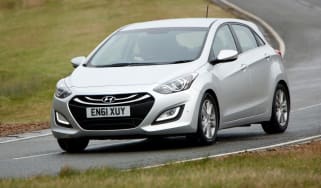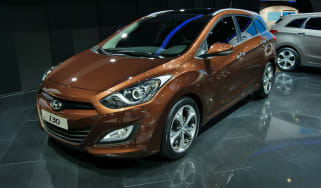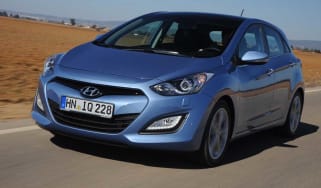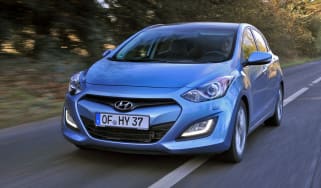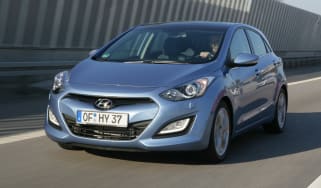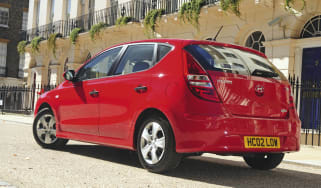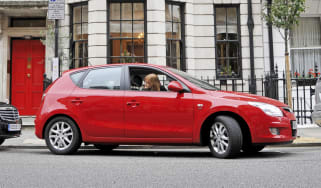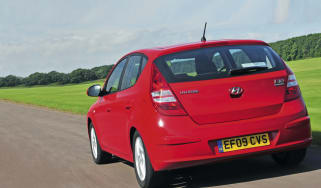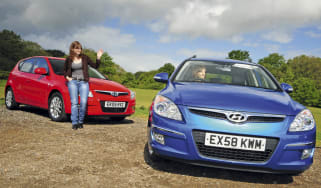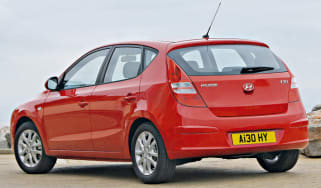Hyundai i30 Tourer review
Spacious, economical, safe, and well-equipped, but an unrewarding drive lets the Hyundai i30 Tourer down

The i30 hatchback is Hyundai’s most ambitious assault on the European market, aiming to compete in a sector that’s dominated by a huge range of successfully established models like the Ford Focus, Vauxhall Astra and Volkswagen Golf.
The Hyundai i30 Tourer is a spacious estate car variant that broadens the front the model is fighting on. As well as the Focus and Astra Estates, it aims to compete with an array of models that includes the Peugeot 308 SW, Renault Megane Sport Tourer, SEAT Leon ST and Skoda Octavia estates. The Hyundai also has a Kia branded sister-model called the Cee’d Sportswagon.
The i30 Tourer was unveiled at the Geneva Motor Show in March 2017, and although it’s based on the same platform as the hatchback, an extended rear end allows for significantly more boot space.
The i30 features a new range of engines including turbocharged petrols and punchy diesels. All offer relatively high outputs from small capacities, and there’s also a newly developed dual-clutch seven-speed gearbox with Normal and Sport drive modes.
The Tourer model is available in four trim levels, and the range kicks off with the entry S model. It comes with 15-inch alloy wheels, body-coloured bumpers and mirrors, a rear spoiler with integrated LED brake light and a black grille. This model lacks the chrome grille inserts and roof rails of all higher spec cars, however. You also get manual air conditioning, automatic headlights, cruise control and a DAB radio with Bluetooth, but you need to go up a grade to the much better-equipped SE for a five-inch touchscreen which also comes with reversing camera.
More reviews
Car group tests
In-depth reviews
Road tests
- New Hyundai i30 N Performance DCT 2021 review
- New Hyundai i30 N Fastback DCT 2020 review
- New Hyundai i30 Fastback N Line 2020 review
Used car tests
The SE Nav spec level brings you a larger eight-inch screen with sat-nav, while moving up to the Premium and Premium SE grades adds features such as LED headlamps, dual-zone climate control, rain sensing wipers, privacy glass, keyless-go and an LCD instrument pack. Premium SE includes a panoramic sunroof.
All models from the S upwards include an impressive array of safety kit, with autonomous emergency braking, blind spot detection, lane-keeping assistance and hill-start assist fitted as standard features.
The Hyundai i30 Tourer is a good-looking and very roomy estate car, with a classy exterior and a pleasingly appointed cabin. It’s very well-equipped with toys and gadgets, especially if you pick a higher-spec model, and the engine line-up – while limited to just four options – is highly efficient.
It comes with an impressive array of safety tech too, and Hyundai’s excellent five-year warranty. With attractive pricing, it all means the i30 is a tempting choice for those who rate affordability and value over premium badges. On the road the i30 is a comfortable cruiser, but the unengaging handling make it less rewarding on twistier roads or around town.
Engines, performance and drive
Positives first, and the Hyundai i30 Tourer is a great car for racking up motorway miles. It’s surprisingly refined at higher speeds, with suspension that soaks up bumps easily. And if you pick the dual clutch auto option, progress is smoother and more serene.
Elsewhere, like its hatchback sister model, the i30 is not unpleasant to drive, but it’s by no means engaging. The ride is not quite as well resolved at medium speeds, when it can get a little bouncy on uneven surfaces. Around town you’ll find potholes and manhole covers can create intrusive thumps and bumps.
The steering isn’t particularly well set-up for British roads either, as it’s really rather vague. It seems a bit too sensitive to surface changes, too, which means frequent corrections.
If you do most of your miles on the motorway you’ll be pretty well satisfied, but if you drive a lot of B-roads or on twisting country lanes, there are other plenty of rival cars that will reward you with better dynamic performance.
Engines
There are two diesel options, offering either 108bhp or 134bhp from the same 1.6-litre motor. Petrol choices are limited to the same 1.0 and 1.4-litre turbo petrol units as the i30 hatch. There is no hot i30 N Tourer for the time being.
The diesel is smooth and refined in either guise, and offers superb economy. Performance is adequate but not electrifying, as the lower-powered unit offers 0-62mph in 11.3 seconds, while the range-topper does it in 10.9 seconds with the help of its standard dual clutch auto transmission. However, if you regularly load up the car with passenger or luggage – as many who buy this car will – it’s a great choice.
The smaller petrol does 0-62mph in 11.4 seconds, but a full bootload will slow it down further. The smooth and free-revving 1.4T does 0-62mph in 9.2 seconds and feels much punchier. You can pick the more powerful petrol engine with your choice of six-speed manual or seven-speed auto, too, which is another point in its favour.
MPG, CO2 and Running Costs
The Hyundai i30 Tourer stacks up pretty well in the affordability stakes, thanks to competitive pricing and a pretty lavish equipment list – especially if you can run to one of the top-end models. The engines all offer impressive economy and emissions, too, meaning you’re not going to be stung whichever drivetrain you choose.
If you want to follow the path of greatest efficiency, the 108bhp diesel is the engine to pick. It returns an impressive 74.3mpg on the official test cycle. That said, the stronger 134bhp diesel fares pretty well too, with an official 65.7mpg figure. This engine will be better if you’re regularly carrying heavy loads.
The 1.0-litre petrol engine is said to return 54.3mpg, while the 1.4-litre engine is quoted at 51.4mpg. As usual though, much will depend on your driving style, but the figures are still useful for comparison with rival models. The 1.0 turbo is sweet, but be sure you won’t be regularly overloading it before opting for the cheapest car.
CO2 emissions are quoted at 11g/km for the 1.0 petrol and 129g/km for the 1.4. The less powerful diesel produces 99g/km (a boon for business car drivers), while the 134bhp diesel comes in at 112g/km.
Speaking of company car users will face Benefit-in-Kind ratings of 21 and 24 per cent for diesel models, or 22 and 24 per cent for the petrols. Road tax/VED liability for all four powertrain variants is £140 per year, however.
Insurance groups
Hyundai i30 insurance quotes should be pretty competitive, as the entry model starts at an affordable Group 8 rating and even the most powerful flagship model comes in at a relatively lowly Group 15. There is no range-topping i30 N, as there is in the hatchback line-up.
Depreciation
The Hyundai’s rate of depreciation is not too savage these days, but it’s still not particularly heart-warming to think your £21k investment – the approximate price of a 108bhp diesel SE Nav spec car – might be worth as little as £8,000 after three years and 30,000 miles.
Interior, design and technology
While the front of the Hyundai i30 Tourer is identical to the hatch, the extra length of the estate model gives it a different look at the rear. There’s a relatively high roofline that dips down to a sloping rear screen, adorned at the top with a spoiler. The effect is very much in the style of the vogueish ‘lifestyle’ estate, rather than the boxy outline of an ultimate load carrier. Indeed, more expensive models with roof rails, LED lighting and bigger alloy wheels present quite an upmarket appearance. The chrome-highlighted grille is said to have a form inspired by cascading molten steel, and it is certainly eye-catching.
Inside Hyundai reckons the design offers calm simplicity, with a perceptible feeling of elegance, quality and space. We’d agree, but only up to a point. There are plenty of soft touch materials with a quality feel, but you don’t have to look far to find scratchier, harder plastics, and the central dash panel has a slightly cheap edge.
The overall design is pleasing though, and the responsive infotainment touchscreen in the centre of the dash is easy to use, while traditional knobs for heating and air-con make life easier, too. The dashboard is well laid out, and the instruments are clear and simple to read.
Infotainment and sat-nav
The entry level S model has a five-inch monochrome display in the centre of the dash with no touch functionality, while the SE gets a five-inch colour touchscreen, which includes a reversing camera but no sat-nav function. SE Nav grade and above bumps you up to the big eight-inch screen with sat-nav, and the system comes with Apple CarPlay and Android Auto to help you connect your phone.
Practicality, comfort and boot space
The Hyundai i30 Tourer has the look of a lifestyle estate, but that swoopy rear end is deceptively spacious. It may not be best in class, but it has a decent boot volume – and passengers don’t suffer for it either.
There’s plenty of seat adjustment, and rake and reach adjustment for the steering wheel on all models. Front seat occupants also benefit from large door bins and an oddments area ahead of the gear lever that’s handy for your phone.
Size
The i30 Tourer model is 245mm longer than the five-door hatchback, but no wider – it shares much of its sheet metal up front, after all. At 4,585mm long and 1,795mm wide it’s a little longer but narrower than the SEAT Leon ST estate (4,246mm x 1,816mm), but smaller all round than the Vauxhall Astra Sports Tourer (4,702mm x 1,809mm).
Leg room, head room & passenger space
The i30 is roomy enough up front, but the Tourer model is better than the five-door for rear passengers – the Tourer’s swoopy dip in the rear roofline doesn’t start downwards until it’s behind the rear passengers’ heads. As a result, there’s more air above their scalps than you find in the hatchback model. Rear knee-room is adequate too, even for taller adults, but it’s not as spacious as a Skoda Octavia.
Boot
Hyundai i30 Tourer’s boot compares pretty well with rivals, as it sits somewhere in the middle of the pack. While the hatchback i30 makes do with 395 litres, the Tourer has an impressive 602 litres – which virtually matches VW Golf estate. With the seats folded you get 1,650 litres, and thanks to the large square rear tailgate it’s a very usable space.
Reliability and Safety
When it comes to safety, you can’t argue with Hyundai’s approach. The i30 Tourer is loaded with kit, including autonomous emergency braking, front collision warning, lane-keeping assistance and driver attention alert – all as standard equipment on every model. It’s an impressive array, and you can also add optional rear cross traffic alert for optimum reassurance while reversing.
As a result, and thanks to solid engineering, the i30 (albeit in hatchback guise) scored a full five stars in the Euro NCAP independent crash tests. It’s 88 per cent safety ranking put it near the top of the class in the compact sector, and there’s no obvious reason why the Tourer estate variant should fare any worse.
Reliability should be fine too. At one point the previous generation i30 was the top finisher in our Driver Power Survey, and while it fell from grace as it aged, the ratings for reliability have never given cause for concern.
Warranty
Korean manufacturers lead the way in warranty terms, and while Hyundai doesn’t match Kia’s seven-year cover, the i30 Tourer’s five-year cover comes with no mileage cap. The Kia cover runs out at 100,000 miles, so drivers doing consistently high mileages may find Hyundai’s offer more attractive.
Either way, it’s a lot better than the three-year, 60,000-mile cover offered by rivals such as Vauxhall and Volkswagen.
Servicing
Service intervals for the i30 Tourer are set at one year or 10,000 miles, and dealers offer fixed price servicing with two, three, or five-year packages available. The cost ranges from £249 to £649 (for two or six years) for petrol cars, and £349 to £749 for diesels.



